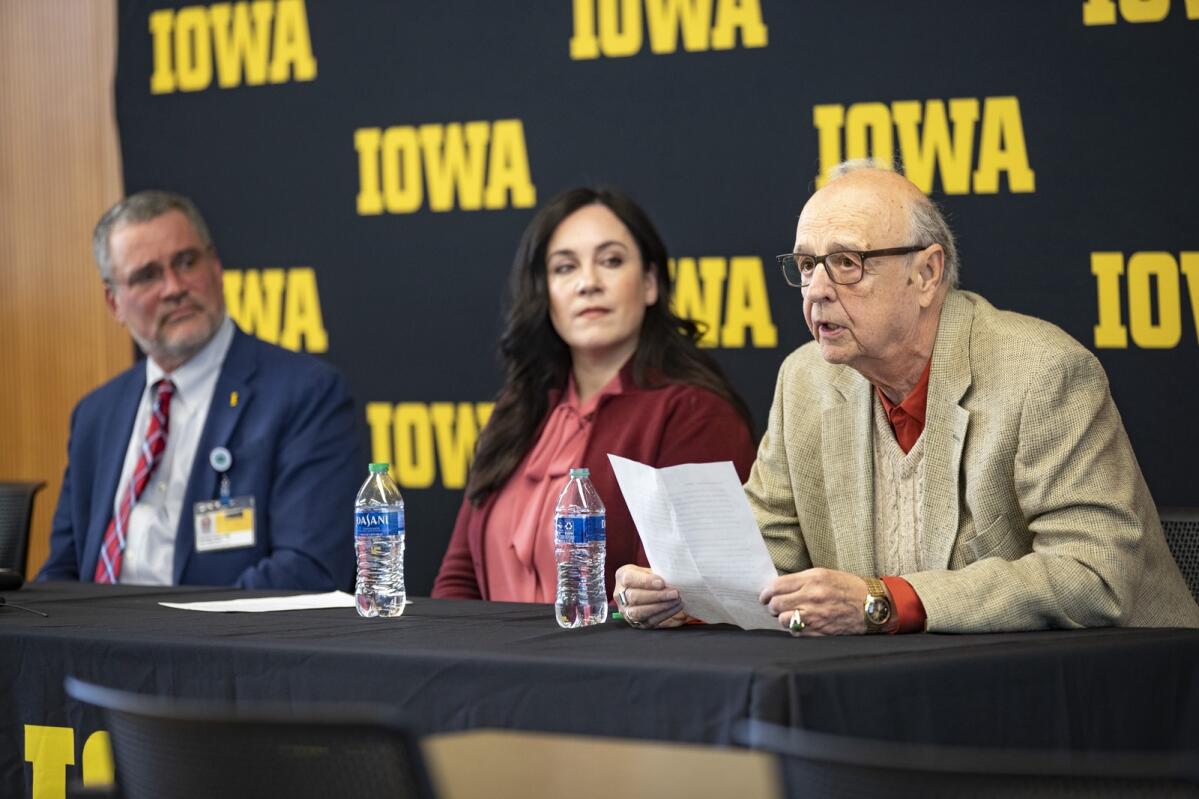Iowa continues to have the second highest cancer rate in the nation — and the fastest growing rate of new cancers, with another 21,000 estimated this year — according to the Iowa Cancer Registry’s 2024 “Cancer in Iowa” report.
And while a confluence of factors are believed to be behind the state’s rising cancer rates — making it the only state in the nation reporting a significant increase in incidence from 2015 to 2019 — one piece of the problematic puzzle is Iowa’s high rates of alcohol use and abuse, according to the new report made public Tuesday.
Alcohol is a known carcinogen and a risk factor for cancers like oral cavity, pharynx, larynx, esophagus, colon and rectum, liver, prostate, and breast cancer. Iowa has the fourth highest incidence of alcohol-related cancers in the country — and the highest in the Midwest — matching its fourth-highest ranking for adult binge drinking.
“It's pervasive throughout our state; I think it's a cultural thing in our state, and it’s something that I think people need to be aware of,” Mary Charlton, professor of epidemiology and director of the Iowa Cancer Registry at the University of Iowa, told reporters Tuesday — citing a 2023 study that found, “Only 40 percent of the general public even knew that alcohol could contribute or cause cancer.”
That study found alcohol contributed to an average of more than 75,000 cancer cases and 19,000 cancer deaths a year from 2013 to 2016 — and that more than 10 percent of U.S. adults actually believed wine lowered cancer risk.
“All beverage types containing ethanol (e.g., wine, beer, liquor) increase cancer risk,” according to the study.
The amount of alcohol seems to matter more than type — from wine to whiskey to that beverage central to the Hawkeye-victory song about drinking here because, “In heaven there is no beer.”
“Alcohol is one modifiable risk where Iowans stand out from the rest of the country, and that may be contributing to our high cancer rates,” Charlton said. “My main message today is meant to be a literal buzz kill.”
Defining binge drinking as five or more drinks on one occasion for men and four or more drinks for women, more than one-fifth — or 22 percent — of adults in Iowa reported binge drinking in 2022, meaningfully above the national average of 17 percent.
Men more often binge drink than women, and Iowans making more than $100,000 a year binge drink at significantly higher rates than those making $50,000 or less — at more than 30 percent, compared to under 20 percent among the lower income brackets.
Most counties in Iowa report higher binge drinking rates than the national average — with Jackson County reporting the highest rate at 27 percent and Polk, Johnson, and Linn counties reporting rates of 23 percent, 21 percent, and 19 percent, respectively.
The highest rate of binge drinking in Iowa is among those ages 25 to 34. But binge drinking is a concern for young people too, with 23 percent of Iowans ages 12 to 20 having at least one drink and 15 percent reporting binge drinking.
That is a concern given findings from research on the connection between alcohol and cancer, according to Michael Henry, interim director of the UI Holden Comprehensive Cancer Center.
One recent paper, Henry said, found alcohol exposure for mice at an adolescent stage “can have dramatic consequences on down the road for the risk of developing cancers and then the aggressiveness of those cancers in mice.”
“So it's important to think about exposure at any time,” he said. “But in that adolescent stage, binge drinking, heavy drinking, can potentially have long-lasting effects.”
Alcohol increases cancer risk in several key ways, according to Henry, like by damaging DNA and other molecules and harming the body’s ability to repair damage done to DNA.
“And so that's kind of a double whammy that can lead to accumulation of mutations … accumulation of mutations that can drive cancer,” he said. “But even more than that, it can also cause inflammation and affect the function of our immune system. And that can actually cause cancers that develop to be worse and have worse consequences.”
The good news, Henry said, is reducing alcohol consumption can cut the risk. Updated dietary guidelines for Americans recommend adults either don’t drink or limit their daily consumption to fewer than two drinks for men or no more than one for women.
Among alcohol-tied cancers, Iowa is a leader — with 14 percent of its estimated new cancers this year expected to be breast, another 14 percent expected to be prostate, and 8 percent expected in the colon and rectum category.
John Stokes, 77, of Iowa City, is among Iowa’s 168,610 cancer survivors — having been diagnosed twice, first 13 years ago with “voice box cancer” and again in 2022 with a second head-and-neck cancer on his tongue.
“When I was younger, I had problems with alcohol,” Stokes said, sharing he also smoked. “I drank frequently and would also binge drink. Never during that time did I realize that those choices could cause cancer later in life.”
Stokes said he addressed his alcoholism in 1981 at age 36 but continued smoking until he was 50. His cancer diagnosis didn’t come until nearly four decades after he got sober.
“That's typically what we see,” said Marisa Buchakjian, UI Health Care assistant professor of otolaryngology. “Decades after stopping that exposure, the cells continue to change and build up mutations.”

 www.thegazette.com
www.thegazette.com
And while a confluence of factors are believed to be behind the state’s rising cancer rates — making it the only state in the nation reporting a significant increase in incidence from 2015 to 2019 — one piece of the problematic puzzle is Iowa’s high rates of alcohol use and abuse, according to the new report made public Tuesday.
Alcohol is a known carcinogen and a risk factor for cancers like oral cavity, pharynx, larynx, esophagus, colon and rectum, liver, prostate, and breast cancer. Iowa has the fourth highest incidence of alcohol-related cancers in the country — and the highest in the Midwest — matching its fourth-highest ranking for adult binge drinking.
“It's pervasive throughout our state; I think it's a cultural thing in our state, and it’s something that I think people need to be aware of,” Mary Charlton, professor of epidemiology and director of the Iowa Cancer Registry at the University of Iowa, told reporters Tuesday — citing a 2023 study that found, “Only 40 percent of the general public even knew that alcohol could contribute or cause cancer.”
That study found alcohol contributed to an average of more than 75,000 cancer cases and 19,000 cancer deaths a year from 2013 to 2016 — and that more than 10 percent of U.S. adults actually believed wine lowered cancer risk.
“All beverage types containing ethanol (e.g., wine, beer, liquor) increase cancer risk,” according to the study.
The amount of alcohol seems to matter more than type — from wine to whiskey to that beverage central to the Hawkeye-victory song about drinking here because, “In heaven there is no beer.”
“Alcohol is one modifiable risk where Iowans stand out from the rest of the country, and that may be contributing to our high cancer rates,” Charlton said. “My main message today is meant to be a literal buzz kill.”
Iowa drinking rates
Defining binge drinking as five or more drinks on one occasion for men and four or more drinks for women, more than one-fifth — or 22 percent — of adults in Iowa reported binge drinking in 2022, meaningfully above the national average of 17 percent.
Men more often binge drink than women, and Iowans making more than $100,000 a year binge drink at significantly higher rates than those making $50,000 or less — at more than 30 percent, compared to under 20 percent among the lower income brackets.
Most counties in Iowa report higher binge drinking rates than the national average — with Jackson County reporting the highest rate at 27 percent and Polk, Johnson, and Linn counties reporting rates of 23 percent, 21 percent, and 19 percent, respectively.
The highest rate of binge drinking in Iowa is among those ages 25 to 34. But binge drinking is a concern for young people too, with 23 percent of Iowans ages 12 to 20 having at least one drink and 15 percent reporting binge drinking.
That is a concern given findings from research on the connection between alcohol and cancer, according to Michael Henry, interim director of the UI Holden Comprehensive Cancer Center.
One recent paper, Henry said, found alcohol exposure for mice at an adolescent stage “can have dramatic consequences on down the road for the risk of developing cancers and then the aggressiveness of those cancers in mice.”
“So it's important to think about exposure at any time,” he said. “But in that adolescent stage, binge drinking, heavy drinking, can potentially have long-lasting effects.”
‘I had problems with alcohol’
Alcohol increases cancer risk in several key ways, according to Henry, like by damaging DNA and other molecules and harming the body’s ability to repair damage done to DNA.
“And so that's kind of a double whammy that can lead to accumulation of mutations … accumulation of mutations that can drive cancer,” he said. “But even more than that, it can also cause inflammation and affect the function of our immune system. And that can actually cause cancers that develop to be worse and have worse consequences.”
The good news, Henry said, is reducing alcohol consumption can cut the risk. Updated dietary guidelines for Americans recommend adults either don’t drink or limit their daily consumption to fewer than two drinks for men or no more than one for women.
Among alcohol-tied cancers, Iowa is a leader — with 14 percent of its estimated new cancers this year expected to be breast, another 14 percent expected to be prostate, and 8 percent expected in the colon and rectum category.
John Stokes, 77, of Iowa City, is among Iowa’s 168,610 cancer survivors — having been diagnosed twice, first 13 years ago with “voice box cancer” and again in 2022 with a second head-and-neck cancer on his tongue.
“When I was younger, I had problems with alcohol,” Stokes said, sharing he also smoked. “I drank frequently and would also binge drink. Never during that time did I realize that those choices could cause cancer later in life.”
Stokes said he addressed his alcoholism in 1981 at age 36 but continued smoking until he was 50. His cancer diagnosis didn’t come until nearly four decades after he got sober.
“That's typically what we see,” said Marisa Buchakjian, UI Health Care assistant professor of otolaryngology. “Decades after stopping that exposure, the cells continue to change and build up mutations.”
Alcohol could be tied to Iowa’s fastest-growing cancer rate
Iowa continues to have the second highest cancer rate in the nation — and the fastest growing rate of new cancers, with another 21,000 estimated this year — according to the Iowa Cancer Registry’s 2024 “Cancer in Iowa” report.


